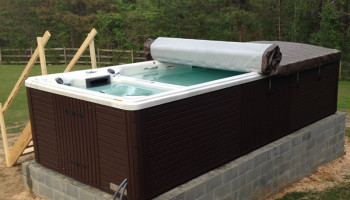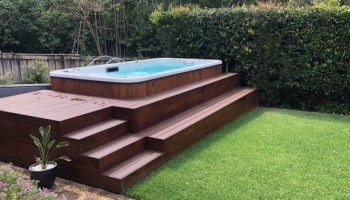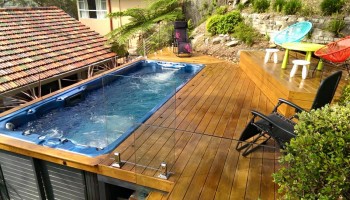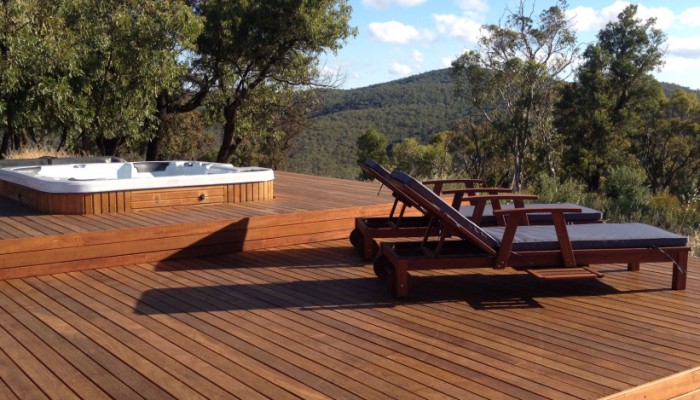
Whether you’ve already chosen your spa or are still weighing up your options, installation is the step that makes or breaks the experience.
A spa or swim spa can give you the benefits of a backyard pool — fitness, family time, and year-round relaxation — without the cost and hassle of a traditional pool.
But in Sydney, installation isn’t as simple as dropping it into place.
You’ll need to think about council approvals, a solid foundation, electrical work, access for delivery, and safety compliance before you can take your first dip.
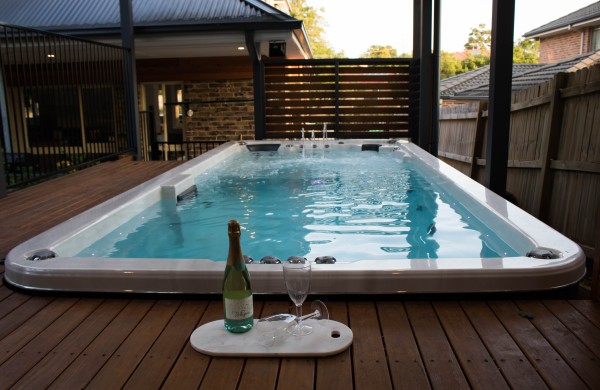
This guide walks you through the process step by step, with practical advice on what to expect and how to prepare.
And if you’d prefer to have it all handled for you, mySpa Sydney offers a complete installation service — from approvals and crane hire through to landscaping and aftercare.
See the difference and book a dip at our Castle Hill showroom to experience an Australian-made spa before you buy.
Spa Installation Costs to Budget for
When planning your spa or swim spa installation, it helps to know what expenses are likely to come up and when.
Some steps need to be locked in weeks in advance, as council paperwork, contractors, or concrete curing can add time before delivery.
Here’s what to prepare for:
- Planning approvals (CDC or DA, if required): You’ll need a Complying Development Certificate (CDC) and potentially a DA as well. This should be the first step before any site work begins.
- Site preparation & excavation: Clearing or levelling the area, removing old structures, or reshaping landscaping.
- Concrete slab and surrounding decking: A reinforced base needs to be designed, poured, and cured before the spa can be delivered.
- Electrical work: Installing a dedicated power supply, safety switch, and any trenching that needs to happen before the slab is finalised.
- Plumbing or drainage (if required): Most spas only need a hose connection, but recessed or in-deck installs may need dedicated drainage.
- Crane or Hiab hire for delivery: Larger spas and swim spas require lifting into place.
- Fencing, lockable cover, and CPR signage: Safety requirements under NSW law must be in place before your spa can be filled and used
- Landscaping and finishing touches: Steps, decking, shade, and lighting to complete the space around your spa.
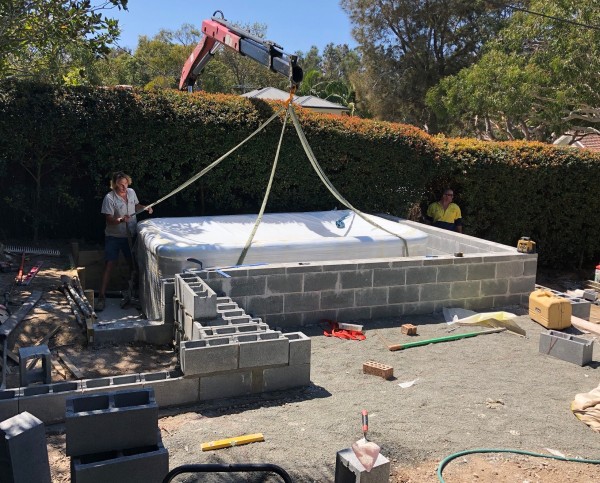
While these costs can add up if managed separately, mySpa Sydney can provide a single, coordinated installation service. That means one team, one timeline, and one clear price.
Mistakes to Avoid with Spa and Swim Spa Installation
Installing a spa or swim spa isn’t just about picking the model; it’s about getting the setup right.
Here are the common mistakes we see that can slow things down or cause costly rework:
| Spa installation mistake | Why? |
| Underestimating the timeline | Council paperwork, site prep, concrete curing, and contractor scheduling can stretch the process over months, not weeks. |
| Not checking compliance early | Rules around safety fencing and electrical safety vary across NSW councils. Delaying approvals can stall the whole project. |
| Choosing contractors without spa experience | A general builder or electrician may not understand the unique requirements of spa installation, which can void warranties or create safety risks. |
| Forgetting site access logistics | Tight driveways, narrow gates, or overhead power lines can mean you’ll need a crane, and that requires planning. |
| Leaving landscaping as an afterthought | Decking, shade, and lighting are easier to plan before the spa goes in, not after. |
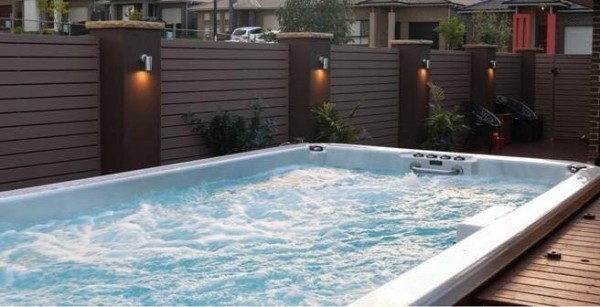
mySpa Sydney has managed hundreds of spa and swim spa installations across Sydney.
We know the pitfalls and how to avoid them, coordinating contractors and council requirements so you don’t waste time or money.
“My Spa Sydney were amazing in working with me on choice of swim spa and all the other tricky things that need to be done. Sam was at the end of the phone whenever I needed solving issues with being a long distance out of Sydney customer.
The team made my experience of setting up, delivery and fixing issues immediately.
I am so grateful and happy that I went with this company, and I’ll keep in touch because I know they care.”
Google Review from Juanita Sherwood
⭐⭐⭐⭐⭐
Needing a CDC or DA for spa and swim spa installation
In New South Wales, spa and swim spa compliance falls under the same rules as swimming pools.
That means you may need approval before installation, plus safety measures in place before you can fill and use your spa.
This is what you need to consider for compliance before spa or swim spa installation:
- Registration: All spas and swim spas in NSW must be registered on the NSW Government Swimming Pool Register. mySpa Sydney can handle this for you as part of your installation.
- Permits (CDC or DA): Spas under 2,000L don’t need a building permit. Anything larger (including swim spas over 4,000L) requires approval, usually a Complying Development Certificate (CDC). Depending on your site, you may also need a Development Application (DA).
- Fencing and barriers: In most cases, you won’t need a fence if your spa has a compliant, lockable child-safe cover. Without one, you must install a fence at least 1.2m high, with a self-closing outward-opening gate.
- Electrical requirements: Spas and swim spas need their own power supply. A licensed electrician must install a dedicated circuit, safety switch, and (for hardwired models) an isolation switch.
- CPR signage: It’s mandatory in NSW to display a CPR sign near your spa, clearly visible and in good condition.
It’s always best to confirm with your local council and be absolutely sure before installing your spa or swim spa. If your spa isn’t compliant, it can affect your insurance and even your property value when it comes time to sell.
At mySpa Sydney, we guide you through the entire process: from permits and fencing to electrical setup and inspections. That way, you can be confident your spa is safe, legal, and ready to enjoy.
For a full breakdown of NSW spa regulations, read our complete guide: NSW Spa Pool & Swim Spa Regulations and Safety.
How to Prepare the Site and Plan for Landscaping
A successful spa or swim spa installation starts with good planning.
The site needs to be designed not only for the weight and footprint of your spa, but also for how you’ll use the space around it. And it should be beautiful!
- Get expert design advice: A skilled landscape designer can help you map out where the spa will sit, how people will move around it, and where to place features like lighting, shade structures, and privacy screening. Planning early avoids costly rework once the spa is in place.
- Plan the foundation: Most spas and swim spas require a reinforced concrete slab at least 150mm thick, extending beyond the spa’s footprint. This slab must cure before the spa is delivered. If you’re installing on a deck, ensure it’s engineered to take the load. At mySpa Sydney, we usually build decking and steps around the spa to achieve that “sunk-in” look.
- Electrical first: In many cases, the electrician will need to trench cables or install conduit before the slab is poured. Planning this ahead of time saves having to cut into new concrete.
- Allow for spa accessories and access: Don’t forget space for cover lifters, entry steps, or a heat pump alongside your spa. Leaving clearance around all sides makes maintenance easier and keeps the warranty intact.
- Integrate landscaping: Steps, decking, and garden design can enhance the look and safety of your installation. Choosing slip-resistant materials and adding soft lighting make the area safer for night use.
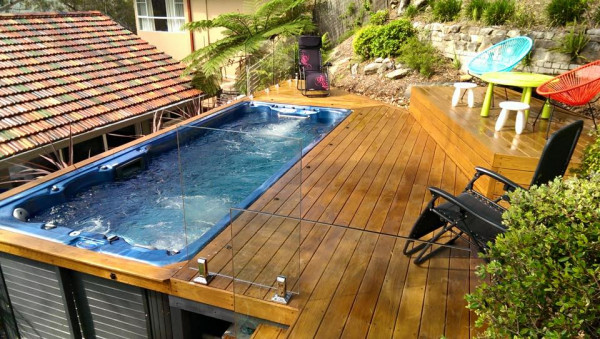
By preparing your site carefully, you’ll not only protect your investment but also create an outdoor space that feels complete from day one.
Arrange for Certifiers and Trades
Installing a spa or swim spa isn’t just about the concrete and delivery. You need the right professionals to ensure everything is compliant and safe.
- Building surveyor or certifier: In NSW, a certifier can confirm whether you need a Complying Development Certificate (CDC) or Development Application (DA). They’ll also inspect the installation, check safety barriers, and submit paperwork to council on your behalf. It’s an extra upfront cost, but it prevents costly mistakes later and protects the value of your home.
- Licensed electrician: All spas and swim spas require their own dedicated power supply, installed by a licensed electrician. This includes a safety switch and, for hardwired models, an isolation switch within three metres of the spa.
- Plumber (if needed): Most spas don’t require permanent plumbing, but if your spa is being recessed into a deck or pit, a plumber may be needed to install drainage.
Coordinating these trades and certifications is time-consuming — especially if you don’t know any at first, and each works to their own schedule.
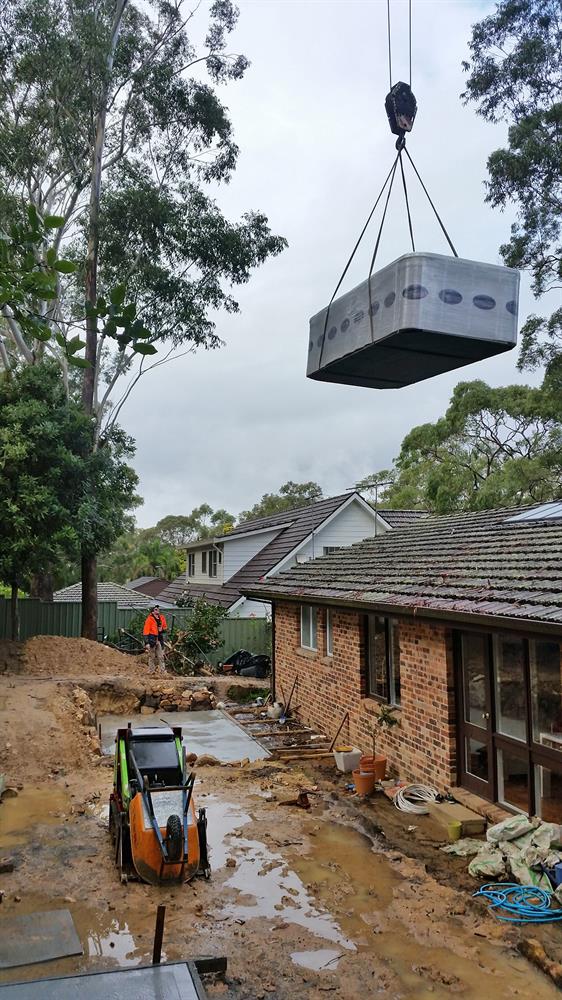
mySpa Sydney handles this process for you, engaging our network of spa-informed tradespeople at the right time so the project runs smoothly from start to finish.
What to Expect on Spa Installation Day
On installation day, most spa and swim spa projects follow the same key steps:
- Delivery and positioning: Your spa will usually arrive by truck and may need to be craned or lifted into place if site access is tight.
- Placement on the foundation: The spa is carefully lowered onto its cured concrete slab or engineered deck.
- Connections: A licensed electrician completes the power hookup. If drainage has been planned (for in-deck or recessed installs), plumbing is finalised.
- Initial fill and system check: The spa is filled with water, filters and pumps are tested, and the heating system is switched on.
- Safety and compliance checks: Barriers, lockable covers, and CPR signage must be in place before the spa can be used.
At mySpa Sydney, we coordinate all of this for you: arranging cranes, managing contractors, and handling approvals so installation is seamless.
We also offer landscaping and decking design to leave your yard looking finished, not like a building site.
For a detailed breakdown of what to expect from start to finish, read our dedicated guide: Swim Spa Installation at mySpa Sydney.
Safety Precautions
Before you can fill and enjoy your spa, NSW law requires a few key safety measures:
- Child safety barrier: Most spas don’t need a separate fence if they have a compliant, lockable hard cover. Without one, you’ll need a pool-style barrier at least 1.2m high with a self-closing gate.
- CPR sign: A resuscitation (CPR) sign must be displayed near your spa, clearly visible and in good condition.
These rules are designed to reduce the risk of injury or drowning, especially for children, and they apply whether you’re installing a spa or a large swim spa.
For a full breakdown of the regulations and how they apply in Sydney, read our guide: NSW Spa Pool & Swim Spa Regulations and Safety.
Fill and Balance your Spa Water
Once your spa is in place, the final step is to fill it with water and prepare it for safe use.
- Filling: Most spas are filled with a garden hose.
- Start-up treatment (shocking): After the first fill, the water needs a “shock” treatment — a high dose of sanitiser to kill bacteria and oxidise contaminants from installation.
- Balance: The pH and alkalinity should be adjusted into the safe range (pH 7.2–7.8; alkalinity 80–120 ppm) before ongoing sanitising begins.
- Ongoing care: After this initial shock, you’ll move into a regular schedule of sanitising, balancing, and weekly spa shocks to keep the water crystal clear.
Why it matters who you buy from: Cheaper, general-use pool chemicals often contain fillers and additives that shorten the lifespan of pumps, jets, and seals — and can cause skin or eye irritation.
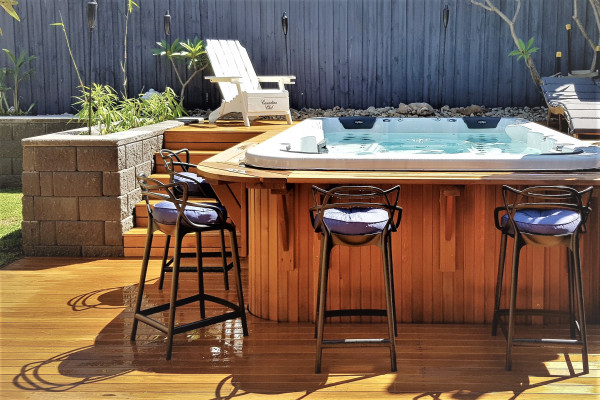
At mySpa Sydney we supply dedicated spa chemicals, formulated for smaller water volumes, balanced dosing, and long-term equipment protection.
See our detailed guide to water care: Spa Chemicals Guide.
Enjoy and Maintain
Once your spa or swim spa is installed, the focus shifts to keeping it in top condition so you can enjoy it for years to come.
Regular spa maintenance involves balancing, sanitising, oxidising, cleaning filters, and seasonal servicing, and it’s the key to clear spa water and reliable long-term performance.
The good news is you don’t have to manage this alone. As a local Sydney showroom, mySpa Sydney provides:
- Premium, spa-specific chemicals and accessories (not generic pool products).
- Expert advice on water care, maintenance schedules, and troubleshooting.
- Ongoing service and repairs to keep your spa running like new.
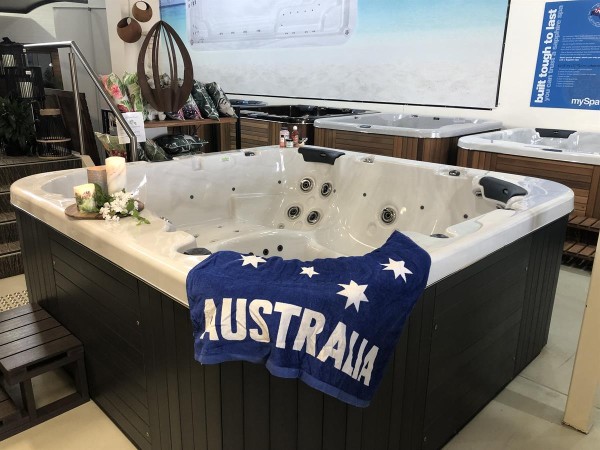
Supporting a local, Australian-made spa company means you’ll have a team here in Sydney to help long after installation — not just at the point of sale.
Ready to see the range in person? Book a dip at our Castle Hill showroom and experience the difference first-hand.
Answering your questions about installing a spa or swim spa
Do I need council approval to install a spa in Sydney?
It depends on the size of your spa. In NSW, smaller spas under 2,000L generally don’t need council approval, but larger spas and swim spas usually require a Complying Development Certificate (CDC) or, in some cases, a Development Application (DA). At mySpa Sydney, we handle this paperwork for you so you don’t get caught up in council red tape.
Do I need to register my spa on the NSW Swimming Pool Register?
Yes, all spas and swim spas in NSW must be registered, just like a swimming pool. We take care of this step as part of your installation, so you can be confident your spa is fully compliant from day one.
Do I need a fence for a spa in NSW?
Not always. If your spa has a compliant, lockable hard cover, you won’t need a separate fence. If not, then you’ll need to install a pool-style fence at least 1.2m high. We’ll make sure your spa meets the safety requirements before you use it.
Can a lockable spa cover replace fencing in NSW?
Yes, as long as the cover meets Australian Standards for child safety. Our CoverMate spa cover lifters are a fully compliant lockable hard cover..
What base or foundation do I need for a spa?
Your spa needs a solid, level base that can take the weight when filled with water and people. For most installs, that means a reinforced 150mm-thick concrete slab. If you’re planning a deck, it needs to be engineered to handle the load. We’ll advise on what’s right for your site.
Can I put a spa on a timber deck?
Potentially, but the deck must be properly engineered to take the weight. We can advise on the best option for your site, but in most cases, we recommend building decking around your spa to achieve the ‘sunk-in’ look.
Does a spa need plumbing in Sydney?
Not usually. Spas and swim spas are filled with a garden hose and emptied using a hose outlet. The only time plumbing might be needed is if you’re recessing the spa into a deck or pit and require dedicated drainage.
What are the electrical requirements for a spa or swim spa?
Spas need their own dedicated power supply, installed by a licensed electrician. Depending on the model, that could be a simple 10A or 15A plug-in, or a hardwired 32A setup for larger swim spas. We’ll organise the right electrical work as part of your install.
Do all spas need to be hardwired, or can I plug one in?
Some smaller spas can plug straight into a standard outdoor socket, but most full-size spas and swim spas need to be hardwired. We’ll match the power setup to your spa model and ensure it’s done safely by a licensed electrician.
Do I need an emergency shut-off switch for my spa?
Yes, NSW regulations require a clearly marked isolation switch within three metres of a hardwired spa or swim spa. We’ll make sure this is installed as part of your electrical setup.
How will my spa or swim spa be delivered in Sydney?
Your spa will arrive on a truck and, depending on access and it may lifted in with a crane. Our team organises the logistics and site checks so delivery day runs smoothly.
Will I need a crane to install a swim spa?
In many Sydney homes, yes — especially if the spa needs to go over a fence, garage, into a tight backyard, or onto an apartment balcony. Don’t worry though: we coordinate the crane hire and all the access requirements for you.
How much does it cost to install a spa in Sydney?
Installation costs vary depending on your site. Things like council approvals, concrete slabs, electrical work, and crane hire all add up. That’s why we provide an upfront quote that covers everything, so you won’t get hit with surprise costs later.
What ongoing costs should I budget for (electricity, chemicals, filters)?
The main running costs are electricity, spa chemicals, and replacement filters. Electricity use will depend on your spa size and usage, but our energy-efficient Sapphire Spas are designed to keep bills low. Filters typically need replacing every 18–24 months, and we supply spa-grade chemicals to make water care simple.
What maintenance does a spa require?
Regular water testing and balancing, cleaning or replacing filters, and giving the spa a quick shock treatment each week. Every season, the spa should be drained and refilled. We also recommend an annual service to keep pumps and heaters running smoothly.
What mistakes should I avoid when installing a spa in Sydney?
The most common mistakes are underestimating the time required for approvals and site prep, choosing contractors without spa experience, and forgetting about access for delivery. Working with a specialist installer like mySpa Sydney helps avoid these headaches.
Can I finance the cost of a spa and installation?
Yes, we can arrange finance options to spread out the cost of your spa and installation. This way you can start enjoying it sooner without waiting until you’ve saved the full amount.

